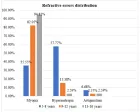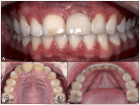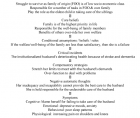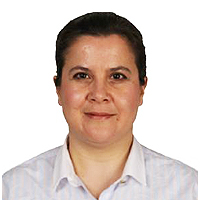Abstract
Research Article
Study of body composition, physiological variables in Grade III obese submitted to arm ergometer test
Renato Vidal Linhares*, Felipe Monnerat Marino Rosa, José Quaresma, João Regis Ivar Carneiro, Valéria Bender Braulio, Roberto Simão, Denise Pires de Carvalho and osé Fernandes Filho
Published: 23 August, 2017 | Volume 1 - Issue 1 | Pages: 023-029
Introduction: Number of obese people is growing on a daily basis in Brazil, including morbid obese ones, but there is still a lack of studies with this subject. Due to this, the main goal of this study was to identify body profile, physiological variables behavior and oxygen consumption in grade III obese women, submitted to an ergospirometric test in arm ergometer.
Method: Take part in this study, thirteen (13) female grade III obese patients between 20 and 40 years. They were submitted to an electric bioimpedance test for body composition measurement and an Ergospirometric test in arm ergometer for oxygen consumption, heart rate, and oxygen saturation, systolic and diastolic arterial pressure, resting and after exercises, analysis.
Results: The patients revealed a BMI of 46.5±3.81 kg/m², 51.9±1.59% of body fat percentage. The patients reached 168.2±4.57bpm of heart rate, didn’t make any hypertensive response to the effort reaching an arterial pressure of 171.1±22.15mmHg x 87.5±4.18mmHg. Oxygen saturation was 98±0.71% and oxygen consumption peak was, also in average, 12.3±2.75ml.kg.min-1.
Conclusion: It was verified that there was no oxygen saturation drop nor hypertensive response and all of the patients reached the maximum heart rate.
Read Full Article HTML DOI: 10.29328/journal.hodms.1001005 Cite this Article Read Full Article PDF
Keywords:
Morbid obesity; Women; Arm ergometry test; Cardiovascular
References
- Godoy-Matos AF, Oliveira J, Guedes EP, Carraro L, Lopes AC, et al. Diretrizes brasileiras de obesidade. Associação Brasileira para o Estudo da Obesidade e da Síndrome Metabólica. 3 ed. Itapevi-SP: AC Farmacêutica. 2009.
- Mechanick JI, Garber AJ, Handelsman Y, Garvey WT. American Association of Clinical Endocrinologists' position statement on obesity and obesity medicine. Endocr Pract. 2012; 18: 642-648. Ref.: https://goo.gl/Qxg6ei
- Oliveira IV. Cirurgia bariátrica no âmbito do sistema único de saúde: tendências custos e complicações [Dissertação de Mestrado]: Universidade de Brasília; 2007. Ref.: https://goo.gl/ot6x3S
- Fornitano LD. O teste ergométrico em indivíduos com obesidade mórbida [Tese de Doutorado]: Faculdade de Medicina de São José do Rio Preto. 2008. Ref.: https://goo.gl/2EsiFf
- Fonseca-Junior SJ, Sá CGAB, Rodrigues PAF, Oliveira AJ, Fernandes-Filho J. Exercício físico e obesidade mórbida: uma revisão sistemática. Arq Bras Cir Dig. 2013; 26: 67-73. Ref.: https://goo.gl/XYcDEK
- Marcon ER, Gus I, Neumann CR. Impacto de um programa mínimo de exercícios físicos supervisionados no risco cardiometabólico de pacientes com obesidade mórbida. Arquivos Braileiro de Endocrinologia e Metabolismo. 2011;55:331-8. Ref.: https://goo.gl/yy8dR3
- Carneiro JRI. Análise de um programa de preparo pré operatório para cirurgia bariátrica com enfase na pratica regular de atividades físicas [Tese de Doutorado]: Universidade Federal do Rio de Janeiro; 2009.
- Pouwels S, Wit M, Teijink JAW, Nienhuijs SW. Aspects of Exercise before or after Bariatric Surgery: A Systematic Review. Obes Facts. 2015; 8: 132-146. Ref.: https://goo.gl/pXroKo
- Fogelholm M, Stallknecht B, Baak M. ECSS position statement: Exercise and obesity. European Journal of Sport Science. 2006; 6: 15-24. Ref.: https://goo.gl/EhhLt2
- Sanches RB, Silva SGA, Rossi S, Fidalgo JPN, Moraes AS, et al. Composição corporal e aptidão aeróbia de mulheres obesas: efeitos benéficos da terapia interdisciplinar. Revista Brasileira de Atividade Física & Saúde. 2013; 18: 354-356.
- Balady GJ, Arena R, Sietsema K, Myers J, Coke L, et al. Clinician's Guide to cardiopulmonary exercise testing in adults: a scientific statement from the American Heart Association. Circulation. 2010; 122: 191-225. Ref.: https://goo.gl/rLMHMT
- Cardoso MCAF, Silva AMT. Oximetria de Pulso: Alternativa Instrumental na Avaliação Clínica junto ao Leito para a Disfagia. Arq Int Otorrinolaringol. 2010; 14: 231-238. Ref.: https://goo.gl/GRKC4v
- Powers SK, Howley ET. Fisiologia do Exercício. Teoria e Aplicação ao Condicionamento e ao Desempenho. 1ª ed ed. Barueri-SP: Manole; 2000.
- Kohlmann Jr O, Guimarães AC, Carvalho MHC, Chaves Jr HC, Machado CA, et al. III Consenso Brasileiro de Hipertensão Arterial. Arq Bras Endocrinol Metab. 1999; 43: 257-286. Ref.: https://goo.gl/xTZWGV
- Polito MD, Farinatti PTV. Respostas de frequência cardíaca, pressão arterial e duplo-produto ao exercício contra-resistência: uma revisão da literatura. Revista Portuguesa de Ciências do Desporto. 2003; 3: 79-91. Ref.: https://goo.gl/sjS1Yg
- Haddad S. Upper limbs ergometry. An important method in the assessment of cardiocirculatory response to exercise. Arq Bras Cardiol. 1997; 69: 189-193. Ref.: https://goo.gl/YXb54Y
- Balady GJ, Weiner DA, Rose L, Ryan TJ. Physiologic response to arm ergometry exercise relative to age and gender. J Am Coll Cardiol. 1990; 16: 130-135. Ref.: https://goo.gl/b1FYDr
- Castro RR, Pedrosa S, Chabalgoity F, Sousa EB, Nobrega AC. The influence of a fast ramp rate on peak cardiopulmonary parameters during arm crank ergometry. Clin Physiol Funct Imaging. 2010; 30: 420-425. Ref.: https://goo.gl/Fy8MTi
- Thomas JR, Jack KN, Silverman SJ. Research Methods in Physical Activity. Champaingn, IL: Human Kinetics; 3rd ed. 1996.
- Ushida A, Moffa P, Hueb W, Cesar L, Ferreira B, et al. Escore Eletrocardiográfico: Aplicação em Ergometria para Avaliação do Precondicionamento Isquêmico. Arq Bras Cardiol. 2010; 95: 486-492. Ref.: https://goo.gl/wZzcZY
- Shvartz E, Reibold RC. Aerobic fitness norms for males and females aged 6 to 75 years: a review. Aviat Space Environ Med. 1990; 61: 3-11. Ref.: https://goo.gl/WZqCQB
- Cooper CB, Storer TW. Teste ergometrico. Aplicações Práticas e Interpretação. 1ª Ed. Rio de Janeiro: Revinter; 2005.
- Meneghelo RS, Araújo CGS, Stein R, Mastrocolla LE, Albuquerque PF, et al./Sociedade Brasileira de Cardiologia. III Diretrizes da Sociedade Brasileira de Cardiologia sobre Teste Ergométrico. Arq Bras Cardiol 2010; 95: 1-26. Ref.: https://goo.gl/GK8vEH
- Stein R. Teste cardiopulmonar de exercício: noções básicas sobre o tema. Revista da Sociedade de Cardiologia do Rio Grande do Sul. 2006; 15: 1-4.
- Leal AA, Faintuch J, Morais AA, Noe JA, Bertollo DM, et al. Bioimpedance analysis: should it be used in morbid obesity? Am J Hum Biol. 2011; 23: 420-422. Ref.: https://goo.gl/SYJmS6
- Walker R, Powers S, Stuart MK. Peak oxygen uptake in arm ergometry: effects of testing protocol. Br J Sports Med. 1986; 20: 25-26. Ref.: https://goo.gl/2q7tzQ
- Mancini MC. Obstáculos e diagnósticos e desafios terapeuticos no paciente obeso. Arq Bras Endocrinol Metab. 2001; 45. Ref.: https://goo.gl/i4K1gz
- Serés L, López-Ayerbe J, Coll R, Rodriguez O, Manresa JM, et al. Cardiopulmonary Function and Exercise Capacity in Patients With Morbid Obesity. Rev Esp Cardiol. 2003; 56: 594-600. Ref.: https://goo.gl/yQhSsb
- Salvadori A, Farani P, Fontana M, Buontempi L, Saezza A, et al. Oxygen uptake and cardiac performance in obese and normal subjects during exercise. Respiration. 1999; 66: 25-33. Ref.: https://goo.gl/Wi8WX8
- Ghorayeb N, Castro I, Daher DJ, Oliveira Filho JA, Oliveira MAB. Diretriz em Cardiologia do Esporte e do Exercício da Sociedade Brasileira de Cardiologia e da Sociedade Brasileira de Medicina do Esporte. Arq Bras Cardiol. 2013; 100: 1-41. Ref.: https://goo.gl/XBggKo
- Serra S. Considerações sobre ergoespirometria. Arq Bras Cardiol. 1997; 68: 301-304. Ref.: https://goo.gl/3E68dJ
- Klefbeck B, Mattsson E, Weinberg J, Svanborg E. Oxygen Desaturations During Exercise and Sleep in Fit Tetraplegic Patients. Arch Phys Med Rehabil. 1998; 79: 800-804. Ref.: https://goo.gl/wTM1Vf
- Faria AG, Ribeiro MAGO, Marson FAL, Schivinski SIS, Severino SD, et al. Effect of exercise test on pulmonary function of obese adolescents. J Pediatr (Rio J). 2014; 90: 242-249. Ref.: https://goo.gl/6u1k9W
- Godoy M, Mantovanini JA, Santana RFT. Teste de Esforço na Mulher. Rev Soc Cardiol Estado de São Paulo. 2001; 3: 621-633. Ref.: https://goo.gl/yVSMAU
- Passaro LC. Resposta cardiovascular na prova de esforço: pressão arterial sistólica. Rev Bras Med Esporte. 1997; 3. Ref.: https://goo.gl/tJBsEv
Similar Articles
-
Cardiac Autonomic Modulation in children and Preadolescents obeseMário Augusto Paschoal*. Cardiac Autonomic Modulation in children and Preadolescents obese. . 2017 doi: 10.29328/journal.hodms.1001002; 1: 007-009
-
Study of body composition, physiological variables in Grade III obese submitted to arm ergometer testRenato Vidal Linhares*,Felipe Monnerat Marino Rosa,José Quaresma,João Regis Ivar Carneiro,Valéria Bender Braulio,Roberto Simão,Denise Pires de Carvalho,osé Fernandes Filho. Study of body composition, physiological variables in Grade III obese submitted to arm ergometer test . . 2017 doi: 10.29328/journal.hodms.1001005; 1: 023-029
-
Dietary and Lifestyles assessment among Obese Women in Gaza City, PalestineMarwan O Jalambo*,Basil Kanoa,Mohammed S Ellulu,Smaher Younis,Mueen El-Kariri. Dietary and Lifestyles assessment among Obese Women in Gaza City, Palestine. . 2018 doi: 10.29328/journal.niogb.1001009; 2: 017-025
-
Obesity-Treatment by drugsSahithi G*. Obesity-Treatment by drugs. . 2019 doi: 10.29328/journal.niogb.1001010; 3: 001-001
-
Pregnancy and exogenous constitutional obesity. possibilities of ozone therapyGrechkanev GO*,Soshnikov AV,Nikishov NN. Pregnancy and exogenous constitutional obesity. possibilities of ozone therapy. . 2023 doi: 10.29328/journal.niogb.1001019; 7: 001-003
Recently Viewed
-
Penile Fracture: The “Cracking” Sound and Intra-operative Tunica Albuginea RepairAyoub Mamad*,Mohammed Amine Bibat,Mohammed Amine Elafari,Youssef Maachi,Amine Slaoui,Tarik Karmouni,Abdelatif Koutani,Khalid Elkhader. Penile Fracture: The “Cracking” Sound and Intra-operative Tunica Albuginea Repair. J Clin Med Exp Images. 2026: doi: 10.29328/journal.jcmei.1001038; 10: 001-002
-
New pharmacological strategies in some metabolic endocrine disorder under a toxicological approachLuisetto M*,Ghulam Rasool Mashori,Cabianca luca. New pharmacological strategies in some metabolic endocrine disorder under a toxicological approach. Ann Clin Endocrinol Metabol. 2018: doi: 10.29328/journal.acem.1001006; 2: 015-021
-
Long monitoring of Birds of Elssuki Area. Sinnar State, SudanMohamed Elmekki Ali Elbadawi Hussien*. Long monitoring of Birds of Elssuki Area. Sinnar State, Sudan. Insights Vet Sci. 2024: doi: 10.29328/journal.ivs.1001040; 8: 001-011
-
Complications of External Otitis in HorsesSchusser GF*, Kuhlmann CHR, Scheidemann W. Complications of External Otitis in Horses. Insights Vet Sci. 2024: doi: 10.29328/journal.ivs.1001041; 8: 012-014
-
Myiasis in a Backyard Pig: A Case ReportMd Niamot Ali, Mahdi Hasan, Ireen Sultana Shanta, Md Abu Choudhury, Mustafizur Rahman, Abdulla Al Mamun Bhuyan*. Myiasis in a Backyard Pig: A Case Report. Insights Vet Sci. 2024: doi: 10.29328/journal.ivs.1001042; 8: 015-017
Most Viewed
-
Impact of Latex Sensitization on Asthma and Rhinitis Progression: A Study at Abidjan-Cocody University Hospital - Côte d’Ivoire (Progression of Asthma and Rhinitis related to Latex Sensitization)Dasse Sery Romuald*, KL Siransy, N Koffi, RO Yeboah, EK Nguessan, HA Adou, VP Goran-Kouacou, AU Assi, JY Seri, S Moussa, D Oura, CL Memel, H Koya, E Atoukoula. Impact of Latex Sensitization on Asthma and Rhinitis Progression: A Study at Abidjan-Cocody University Hospital - Côte d’Ivoire (Progression of Asthma and Rhinitis related to Latex Sensitization). Arch Asthma Allergy Immunol. 2024 doi: 10.29328/journal.aaai.1001035; 8: 007-012
-
Causal Link between Human Blood Metabolites and Asthma: An Investigation Using Mendelian RandomizationYong-Qing Zhu, Xiao-Yan Meng, Jing-Hua Yang*. Causal Link between Human Blood Metabolites and Asthma: An Investigation Using Mendelian Randomization. Arch Asthma Allergy Immunol. 2023 doi: 10.29328/journal.aaai.1001032; 7: 012-022
-
An algorithm to safely manage oral food challenge in an office-based setting for children with multiple food allergiesNathalie Cottel,Aïcha Dieme,Véronique Orcel,Yannick Chantran,Mélisande Bourgoin-Heck,Jocelyne Just. An algorithm to safely manage oral food challenge in an office-based setting for children with multiple food allergies. Arch Asthma Allergy Immunol. 2021 doi: 10.29328/journal.aaai.1001027; 5: 030-037
-
Snow white: an allergic girl?Oreste Vittore Brenna*. Snow white: an allergic girl?. Arch Asthma Allergy Immunol. 2022 doi: 10.29328/journal.aaai.1001029; 6: 001-002
-
Cytokine intoxication as a model of cell apoptosis and predict of schizophrenia - like affective disordersElena Viktorovna Drozdova*. Cytokine intoxication as a model of cell apoptosis and predict of schizophrenia - like affective disorders. Arch Asthma Allergy Immunol. 2021 doi: 10.29328/journal.aaai.1001028; 5: 038-040

If you are already a member of our network and need to keep track of any developments regarding a question you have already submitted, click "take me to my Query."
















































































































































